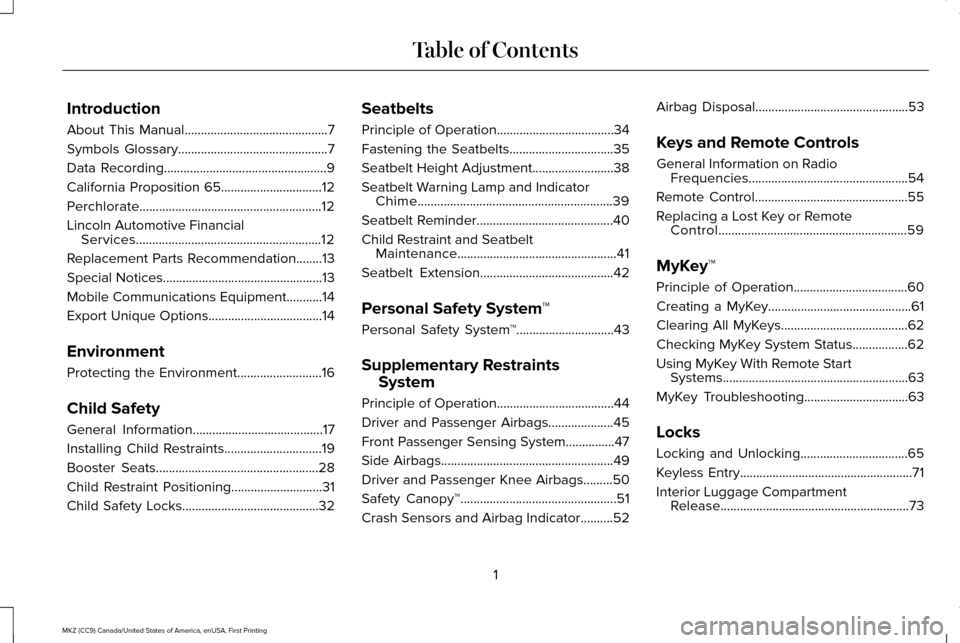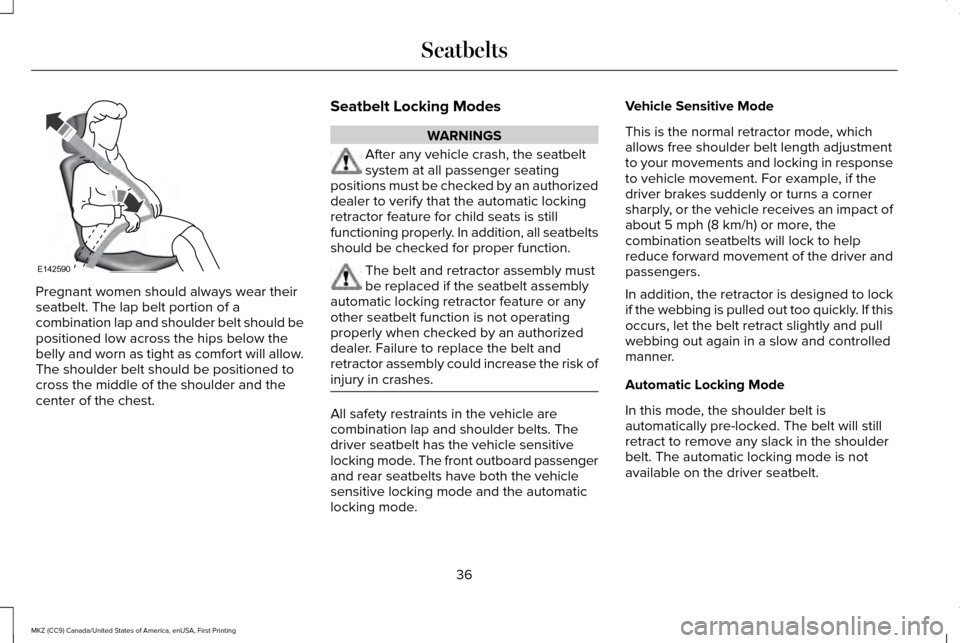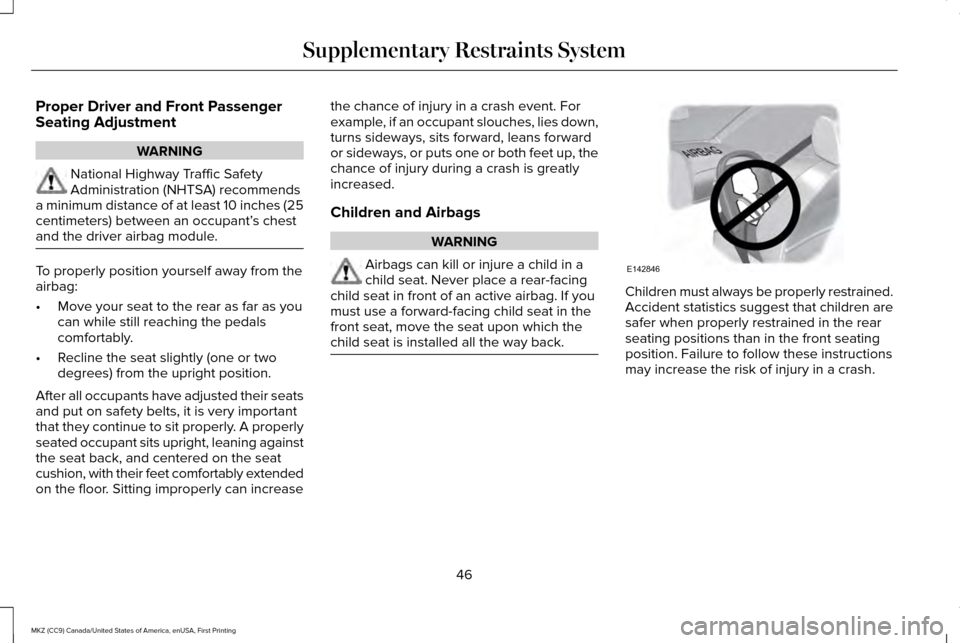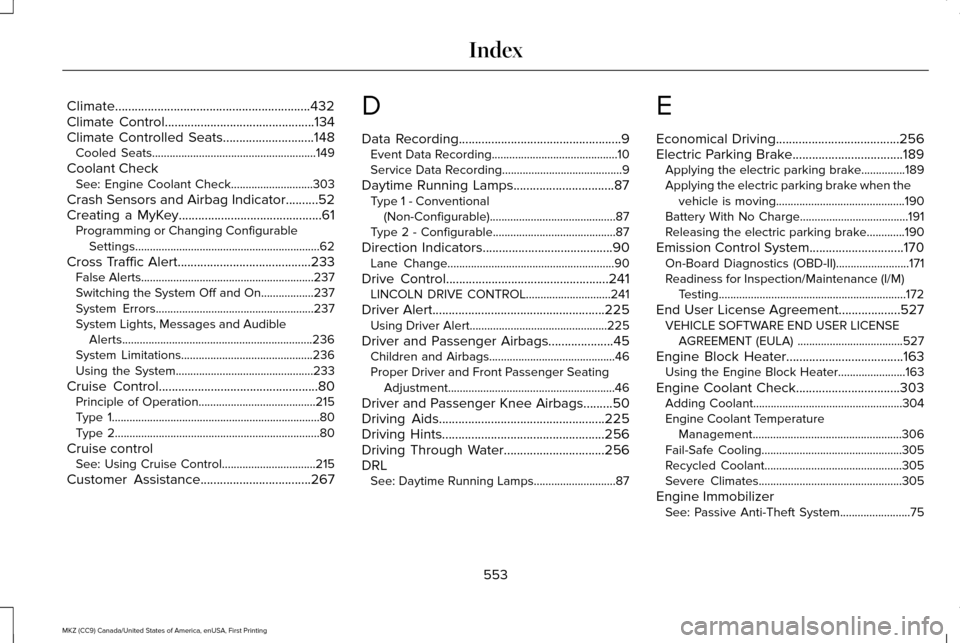driver seat adjustment LINCOLN MKZ 2017 Owners Manual
[x] Cancel search | Manufacturer: LINCOLN, Model Year: 2017, Model line: MKZ, Model: LINCOLN MKZ 2017Pages: 564, PDF Size: 5.54 MB
Page 4 of 564

Introduction
About This Manual............................................7
Symbols Glossary
..............................................7
Data Recording
..................................................9
California Proposition 65
...............................12
Perchlorate........................................................12
Lincoln Automotive Financial Services
.........................................................12
Replacement Parts Recommendation........13
Special Notices
.................................................13
Mobile Communications Equipment
...........14
Export Unique Options...................................14
Environment
Protecting the Environment..........................16
Child Safety
General Information
........................................17
Installing Child Restraints
..............................19
Booster Seats
..................................................28
Child Restraint Positioning
............................31
Child Safety Locks..........................................32 Seatbelts
Principle of Operation....................................34
Fastening the Seatbelts................................35
Seatbelt Height Adjustment.........................38
Seatbelt Warning Lamp and Indicator
Chime
............................................................39
Seatbelt Reminder..........................................40
Child Restraint and Seatbelt Maintenance.................................................41
Seatbelt Extension
.........................................42
Personal Safety System ™
Personal Safety System ™
..............................43
Supplementary Restraints System
Principle of Operation
....................................44
Driver and Passenger Airbags....................45
Front Passenger Sensing System...............47
Side Airbags
.....................................................49
Driver and Passenger Knee Airbags.........50
Safety Canopy™................................................51
Crash Sensors and Airbag Indicator
..........52 Airbag Disposal
...............................................53
Keys and Remote Controls
General Information on Radio Frequencies.................................................54
Remote Control...............................................55
Replacing a Lost Key or Remote Control..........................................................59
MyKey™
Principle of Operation...................................60
Creating a MyKey............................................61
Clearing All MyKeys
.......................................62
Checking MyKey System Status.................62
Using MyKey With Remote Start Systems.........................................................63
MyKey Troubleshooting
................................63
Locks
Locking and Unlocking
.................................65
Keyless Entry.....................................................71
Interior Luggage Compartment Release..........................................................73
1
MKZ (CC9) Canada/United States of America, enUSA, First Printing Table of Contents
Page 39 of 564

Pregnant women should always wear their
seatbelt. The lap belt portion of a
combination lap and shoulder belt should be
positioned low across the hips below the
belly and worn as tight as comfort will allow.
The shoulder belt should be positioned to
cross the middle of the shoulder and the
center of the chest.
Seatbelt Locking Modes WARNINGS
After any vehicle crash, the seatbelt
system at all passenger seating
positions must be checked by an authorized
dealer to verify that the automatic locking
retractor feature for child seats is still
functioning properly. In addition, all seatbelts
should be checked for proper function. The belt and retractor assembly must
be replaced if the seatbelt assembly
automatic locking retractor feature or any
other seatbelt function is not operating
properly when checked by an authorized
dealer. Failure to replace the belt and
retractor assembly could increase the risk of
injury in crashes. All safety restraints in the vehicle are
combination lap and shoulder belts. The
driver seatbelt has the vehicle sensitive
locking mode. The front outboard passenger
and rear seatbelts have both the vehicle
sensitive locking mode and the automatic
locking mode.Vehicle Sensitive Mode
This is the normal retractor mode, which
allows free shoulder belt length adjustment
to your movements and locking in response
to vehicle movement. For example, if the
driver brakes suddenly or turns a corner
sharply, or the vehicle receives an impact of
about 5 mph (8 km/h) or more, the
combination seatbelts will lock to help
reduce forward movement of the driver and
passengers.
In addition, the retractor is designed to lock
if the webbing is pulled out too quickly. If this
occurs, let the belt retract slightly and pull
webbing out again in a slow and controlled
manner.
Automatic Locking Mode
In this mode, the shoulder belt is
automatically pre-locked. The belt will still
retract to remove any slack in the shoulder
belt. The automatic locking mode is not
available on the driver seatbelt.
36
MKZ (CC9) Canada/United States of America, enUSA, First Printing SeatbeltsE142590
Page 49 of 564

Proper Driver and Front Passenger
Seating Adjustment
WARNING
National Highway Traffic Safety
Administration (NHTSA) recommends
a minimum distance of at least 10 inches (25
centimeters) between an occupant’ s chest
and the driver airbag module. To properly position yourself away from the
airbag:
•
Move your seat to the rear as far as you
can while still reaching the pedals
comfortably.
• Recline the seat slightly (one or two
degrees) from the upright position.
After all occupants have adjusted their seats
and put on safety belts, it is very important
that they continue to sit properly. A properly
seated occupant sits upright, leaning against
the seat back, and centered on the seat
cushion, with their feet comfortably extended
on the floor. Sitting improperly can increase the chance of injury in a crash event. For
example, if an occupant slouches, lies down,
turns sideways, sits forward, leans forward
or sideways, or puts one or both feet up, the
chance of injury during a crash is greatly
increased.
Children and Airbags
WARNING
Airbags can kill or injure a child in a
child seat. Never place a rear-facing
child seat in front of an active airbag. If you
must use a forward-facing child seat in the
front seat, move the seat upon which the
child seat is installed all the way back. Children must always be properly restrained.
Accident statistics suggest that children are
safer when properly restrained in the rear
seating positions than in the front seating
position. Failure to follow these instructions
may increase the risk of injury in a crash.
46
MKZ (CC9) Canada/United States of America, enUSA, First Printing Supplementary Restraints SystemE142846
Page 556 of 564

Climate............................................................432
Climate Control..............................................134
Climate Controlled Seats............................148
Cooled Seats........................................................149
Coolant Check See: Engine Coolant Check............................303
Crash Sensors and Airbag Indicator
..........52
Creating a MyKey............................................61 Programming or Changing Configurable
Settings...............................................................62
Cross Traffic Alert.........................................233 False Alerts...........................................................237
Switching the System Off and On..................237
System Errors......................................................237
System Lights, Messages and Audible
Alerts.................................................................236
System Limitations.............................................236
Using the System...............................................233
Cruise Control
.................................................80
Principle of Operation........................................215
Type 1.......................................................................80
Type 2......................................................................80
Cruise control See: Using Cruise Control................................
215
Customer Assistance..................................267 D
Data Recording
..................................................9
Event Data Recording...........................................10
Service Data Recording.........................................9
Daytime Running Lamps
...............................87
Type 1 - Conventional
(Non-Configurable)...........................................87
Type 2 - Configurable..........................................87
Direction Indicators
........................................90
Lane Change.........................................................90
Drive Control
..................................................241
LINCOLN DRIVE CONTROL.............................241
Driver Alert
.....................................................225
Using Driver Alert...............................................225
Driver and Passenger Airbags....................45 Children and Airbags...........................................46
Proper Driver and Front Passenger Seating
Adjustment.........................................................46
Driver and Passenger Knee Airbags.........50
Driving Aids...................................................225
Driving Hints..................................................256
Driving Through Water
...............................256
DRL See: Daytime Running Lamps............................87 E
Economical Driving
......................................256
Electric Parking Brake..................................189
Applying the electric parking brake...............189
Applying the electric parking brake when the
vehicle is moving............................................190
Battery With No Charge.....................................191
Releasing the electric parking brake.............190
Emission Control System
.............................170
On-Board Diagnostics (OBD-II).........................171
Readiness for Inspection/Maintenance (I/M)
Testing................................................................172
End User License Agreement...................527 VEHICLE SOFTWARE END USER LICENSE
AGREEMENT (EULA) ....................................527
Engine Block Heater....................................163 Using the Engine Block Heater.......................163
Engine Coolant Check................................303 Adding Coolant...................................................304
Engine Coolant Temperature
Management...................................................306
Fail-Safe Cooling................................................305
Recycled Coolant...............................................305
Severe Climates.................................................305
Engine Immobilizer See: Passive Anti-Theft System........................75
553
MKZ (CC9) Canada/United States of America, enUSA, First Printing Index